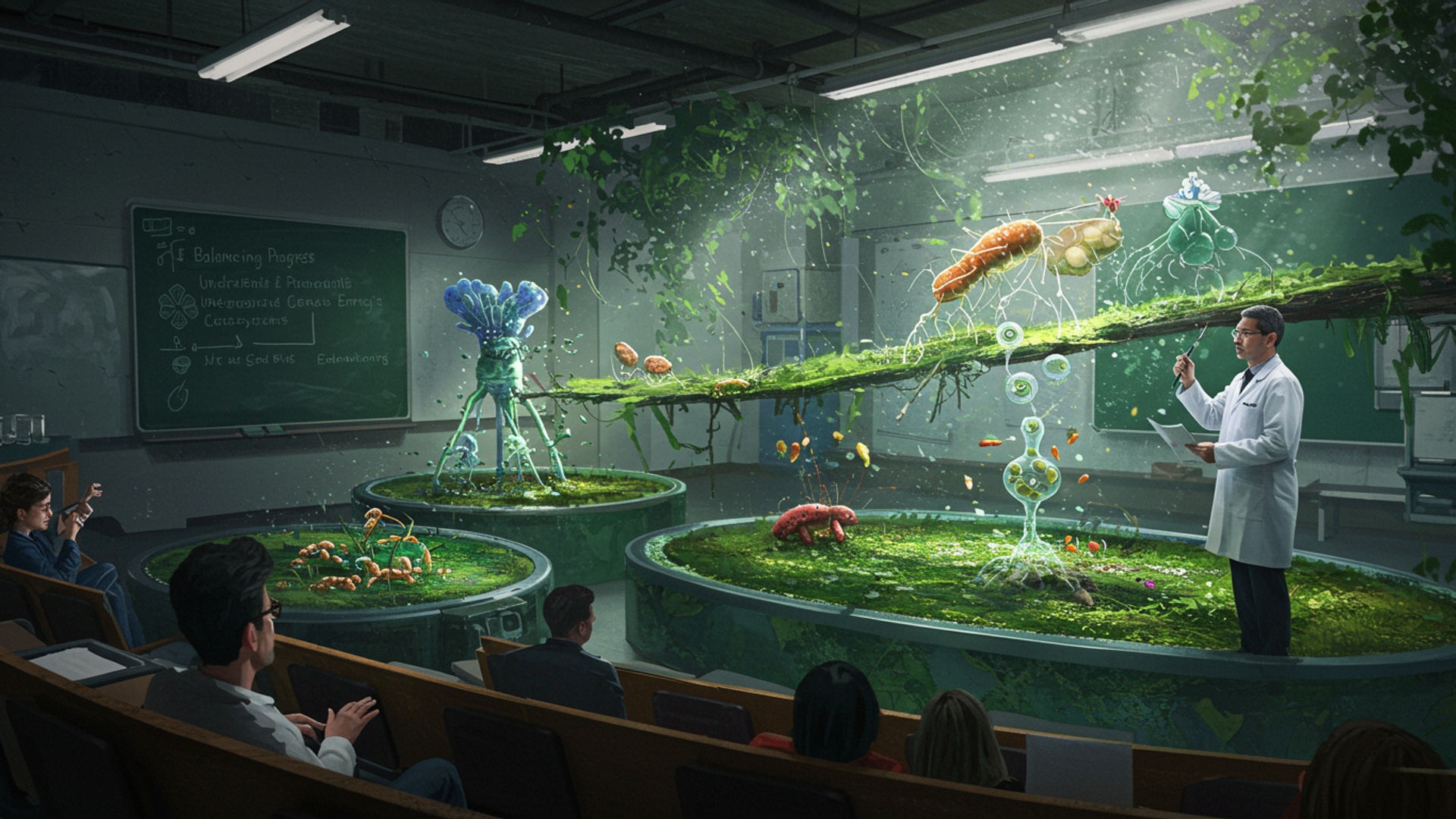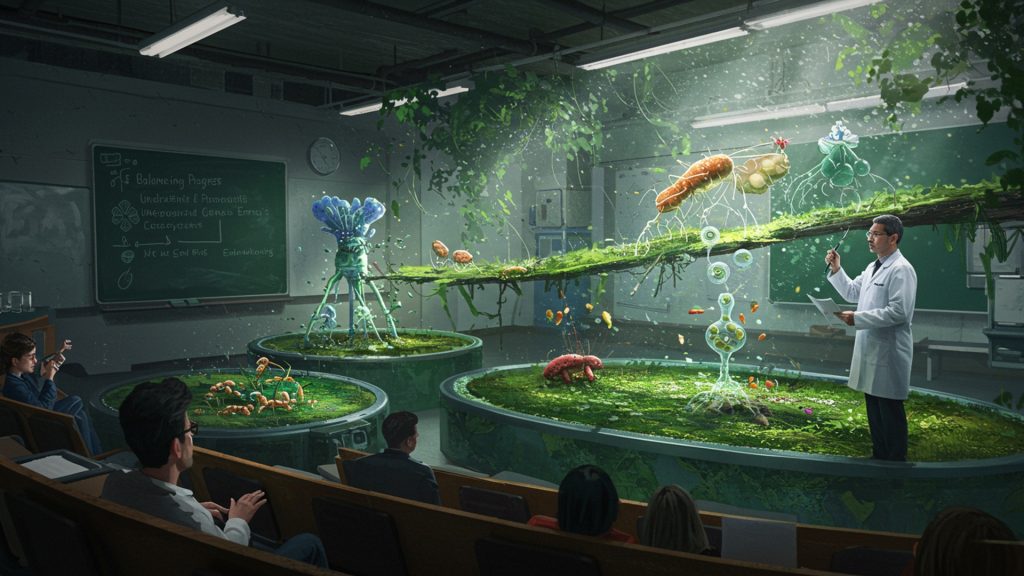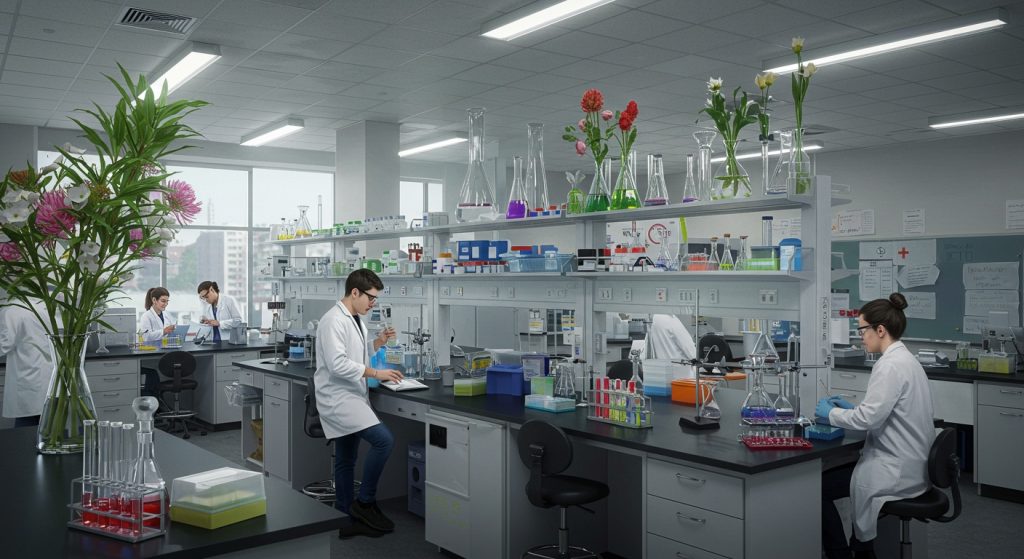Genetic engineering, powered by revolutionary tools like CRISPR-Cas9, rapidly transforms fields from agriculture to medicine, promising innovations like drought-resistant crops and advanced pest control through gene drives. Yet, this profound progress necessitates a critical examination of the environmental impact of genetic engineering. Introducing genetically modified organisms (GMOs) into complex ecosystems risks disrupting natural balances, potentially altering biodiversity through unintended gene flow to wild relatives or creating novel selective pressures. For example, concerns persist regarding insect resistance evolution from widespread Bt crop cultivation, while proposed environmental releases of gene drives for invasive species management present unprecedented challenges in predicting long-term ecological consequences and ensuring containment. Navigating these intricate interactions becomes paramount as humanity explores the frontier of synthetic biology.

Demystifying Genetic Engineering: What It Is and How It Works
Genetic engineering, at its core, is about directly altering an organism’s DNA, its fundamental blueprint. Imagine life’s instruction manual. Traditional breeding might involve shuffling existing pages to get a slightly different version. Genetic engineering, But, allows us to precisely edit specific words, insert new sentences, or even remove paragraphs from that manual. This level of precision is what sets it apart from conventional breeding methods.
The field has evolved dramatically, moving beyond simply transferring genes between species (transgenesis) to highly targeted “gene editing.” One of the most revolutionary technologies in this space is CRISPR-Cas9 (Clustered Regularly Interspaced Short Palindromic Repeats and CRISPR-associated protein 9). Think of CRISPR as a pair of molecular scissors that can be guided to a very specific spot on a DNA strand to cut it. Once cut, the cell’s natural repair mechanisms can be leveraged to either disable a gene, correct a mutation, or insert a new piece of DNA. This precision minimizes unintended changes, making it a powerful tool for scientific exploration and practical application.
Why Genetic Engineering Matters: Diverse Applications
The ability to precisely manipulate DNA opens up a vast array of possibilities across multiple sectors, aiming to solve some of humanity’s most pressing challenges:
- Agriculture
- Medicine
- Conservation
This is perhaps where genetic engineering has had its most visible real-world impact. Genetically modified (GM) crops have been engineered for traits like resistance to pests (e. g. , Bt corn and cotton, which produce an insecticidal protein), tolerance to herbicides (allowing farmers to spray specific weed killers without harming the crop). improved nutritional content (e. g. , Golden Rice, engineered to produce beta-carotene, a precursor to Vitamin A). The promise here is increased yields, reduced reliance on chemical sprays. enhanced food security.
Genetic engineering is a cornerstone of modern medicine. It’s used to produce life-saving drugs like human insulin for diabetics and growth hormones. Gene therapy, a rapidly advancing field, involves introducing new genes into a patient’s cells to treat genetic diseases like cystic fibrosis or certain forms of blindness. It’s also critical in developing disease models for research and in creating more effective vaccines.
Less widely known but incredibly promising is the application of genetic engineering in conservation. Scientists are exploring ways to bolster endangered species’ resistance to diseases (e. g. , engineering American chestnut trees to resist the blight that decimated their population) or to control invasive species by disrupting their reproductive cycles. There’s even talk of “de-extinction” – bringing back extinct species like the woolly mammoth, though this remains highly controversial and technically challenging.
The Core Debate: Unpacking the Environmental Impact of Genetic Engineering
While the potential benefits of genetic engineering are profound, particularly in areas like food security and health, its interaction with natural systems raises crucial questions. The central debate revolves around understanding and mitigating the Environmental impact of genetic engineering, ensuring that our progress doesn’t inadvertently harm the delicate balance of ecosystems. It’s a complex issue with no simple answers, requiring a careful examination of both potential upsides and downsides.
Potential Ecological Upsides: How Genetic Engineering Can Benefit Ecosystems
Despite the controversies, genetic engineering offers several avenues for positive Environmental impact of genetic engineering:
- Reduced Pesticide and Herbicide Use
- Bioremediation
- Enhanced Resource Efficiency
- Conservation of Biodiversity
Perhaps the most direct benefit, particularly from insect-resistant (Bt) and herbicide-tolerant (HT) crops. By engineering plants to resist specific pests or tolerate certain herbicides, farmers can often reduce the overall volume and frequency of chemical applications. For instance, studies have shown significant reductions in insecticide use in areas growing Bt cotton.
Genetically engineered microorganisms can be designed to break down pollutants in soil and water. Imagine bacteria engineered to consume oil spills or clean up heavy metal contamination, offering an innovative approach to environmental restoration that is far less intrusive than traditional methods.
Future GM crops could be engineered to be more efficient in using water, nitrogen, or other nutrients. This would lead to less demand on finite resources and potentially reduce the need for extensive irrigation or synthetic fertilizer application, thereby lessening the agricultural footprint.
As mentioned, genetic engineering holds promise for protecting endangered species by conferring disease resistance (e. g. , saving the Hawaiian honeycreeper from avian malaria) or enhancing their resilience to changing climates. By increasing agricultural productivity on existing land, GM crops could also reduce the pressure to convert natural habitats into farmland, indirectly conserving wild ecosystems.
Navigating the Risks: The Potential Negative Environmental Impact of Genetic Engineering
While the benefits are compelling, concerns regarding the negative Environmental impact of genetic engineering are legitimate and require rigorous assessment:
- Gene Flow and “Superweeds”
- Impact on Non-Target Organisms
- Reduced Biodiversity
- Evolution of Resistance
- Unforeseen Ecological Disruptions
A primary concern is the uncontrolled spread of engineered genes to wild relatives or conventional crops through pollen (gene flow). For example, if herbicide-tolerance genes transfer from GM crops to wild weeds, it could create “superweeds” that are difficult to control, necessitating new, potentially stronger herbicides or more intensive farming practices.
The effects of GM crops on beneficial insects and other organisms are a significant area of study. For instance, initial concerns were raised about the impact of Bt corn pollen on monarch butterfly larvae, though subsequent research has largely mitigated this specific concern under normal field conditions. But, the broader ecological effects on soil microbes, pollinators. food webs still require continuous monitoring.
The widespread adoption of a few genetically uniform GM crop varieties could potentially reduce the genetic diversity of cultivated crops. A narrower genetic base makes crops more vulnerable to new diseases or pests, similar to the historical Irish potato famine caused by reliance on a single potato variety.
Just as pests develop resistance to conventional pesticides, they can also evolve resistance to the traits engineered into GM crops. For example, if insects are continuously exposed to Bt toxins, resistant populations may emerge, diminishing the effectiveness of the GM trait over time. This necessitates careful management strategies, such as planting refugia (non-Bt crops) to slow down resistance development.
Introducing organisms with novel traits into an ecosystem can have unpredictable effects on food webs, nutrient cycles. species interactions. While robust risk assessments aim to minimize this, the complexity of ecosystems means that all potential long-term impacts cannot always be fully predicted.
Real-World Insights: Case Studies in Genetic Engineering and the Environment
Examining specific instances helps us interpret the multifaceted Environmental impact of genetic engineering:
- Bt Crops (Corn, Cotton)
- Positive Impact
- Challenges
- AquaBounty Salmon
- Positive Impact
- Challenges
- American Chestnut Restoration
- Positive Impact
- Challenges
- Golden Rice
- Positive Impact
- Challenges
These crops are engineered to produce proteins from the bacterium Bacillus thuringiensis (Bt) that are toxic to specific insect pests.
Globally, Bt crops have led to significant reductions in insecticide spraying, benefiting farm workers, reducing chemical runoff. allowing beneficial insects to thrive in greater numbers.
Concerns about the evolution of pest resistance have led to mandatory “refugia” strategies, where farmers plant a percentage of non-Bt crops to maintain a susceptible pest population and delay resistance development.
This genetically engineered Atlantic salmon grows twice as fast as conventional salmon, reaching market size in about half the time.
Faster growth means less feed and a reduced environmental footprint for aquaculture, potentially alleviating pressure on wild fish stocks. It’s intended for land-based contained farming, minimizing escape risks.
Despite containment measures, public and environmental groups have expressed concerns about the potential for escape and interbreeding with wild salmon populations, which could outcompete or introduce engineered genes into fragile wild ecosystems.
The American chestnut, once a dominant tree in eastern North America, was decimated by a blight in the early 20th century. Scientists are now using genetic engineering to introduce a gene from wheat that confers resistance to the blight.
This project represents a hopeful example of using genetic engineering for ecological restoration, aiming to bring back a keystone species and restore forest biodiversity.
It’s a long-term project with many hurdles, including ensuring the engineered trees can thrive in wild conditions and gain broad public acceptance.
Developed to combat Vitamin A deficiency, which causes blindness and death in millions, primarily children, in developing countries. It’s engineered to produce beta-carotene in its grains.
Addresses a critical public health issue and offers a sustainable, food-based solution to nutrient deficiency.
While its direct Environmental impact of genetic engineering is considered minimal due to its similarity to conventional rice, its deployment has faced significant socio-political resistance and regulatory delays, preventing its widespread availability.
Balancing Act: Regulation, Ethics. Public Perception
The complex nature of genetic engineering, especially concerning its environmental implications, necessitates robust regulatory frameworks and ongoing ethical discussions.
Regulatory bodies, such as the Food and Drug Administration (FDA), Environmental Protection Agency (EPA). U. S. Department of Agriculture (USDA) in the United States, play a critical role in evaluating the safety of genetically engineered products before they reach the market. Their assessments cover food safety, potential allergenicity, and, crucially, environmental risk, including potential impacts on non-target organisms and the likelihood of gene flow.
Ethical considerations are also paramount. Beyond the scientific data, society grapples with questions like “Are we playing God?” or “What are the long-term, unforeseen consequences of altering nature?” These philosophical debates often intertwine with public perception, which can be influenced by misinformation, lack of understanding, or strong ideological stances. A transparent and science-based dialogue, accessible to the general public, is vital for navigating these complex issues and fostering informed decision-making.
Towards a Sustainable Future: Responsible Innovation and Actionable Steps
Ultimately, balancing the immense potential of genetic engineering with its possible Environmental impact of genetic engineering requires a commitment to responsible innovation. This involves:
- Rigorous Risk Assessment and Monitoring
- Continuous Research and Development
- Public Engagement and Transparency
- Holistic Approaches
Every new genetically engineered organism must undergo thorough, independent scientific evaluation for potential environmental risks, not just before release. also through long-term post-market monitoring. This includes studying gene flow, impacts on biodiversity. the evolution of resistance.
Investing in research that aims to minimize risks, such as developing “containment genes” that prevent gene flow or designing GM crops with more targeted effects on pests.
Open dialogue between scientists, policymakers. the public is crucial. Clear communication about the technology, its benefits, risks. regulatory oversight helps build trust and addresses concerns.
Recognizing that genetic engineering is one tool among many. It should be integrated into broader sustainable agricultural and conservation practices, not seen as a standalone solution.
As individuals, what can we do? Stay informed from credible sources. comprehend that the science is constantly evolving. a nuanced perspective is necessary. Support research and policies that advocate for responsible innovation, prioritizing both human well-being and ecological health. Our collective future depends on harnessing powerful technologies like genetic engineering wisely, ensuring that progress walks hand-in-hand with planetary stewardship.
Conclusion
Balancing progress in genetic engineering, particularly its influence on ecosystems, necessitates a vigilant and informed approach. The rapid advancements, exemplified by CRISPR technology’s precision in editing genes for everything from disease resistance in crops to potential pest control, highlight both immense promise and significant, often unforeseen, ecological ripples. As I’ve observed these developments, it’s clear we must move beyond simplistic narratives. My personal tip for navigating this complex landscape is to actively seek diverse perspectives and support robust, transparent scientific research. Engaging with current trends, like the ongoing debates on gene-edited organisms’ release into natural environments, underscores the need for global collaboration and adaptive regulatory frameworks. We must remain proactive, not reactive, ensuring that innovation aligns with long-term ecological health. Let us collectively embrace this challenge, shaping a future where technological prowess coexists harmoniously with our planet’s intricate biodiversity.
More Articles
Unintended Consequences: The Environmental Risks of Genetic Engineering Explored
Green Biotechnology: How Genetic Engineering Can Protect Our Environment
The Ethics of Gene Editing: Balancing Innovation with Societal Responsibility
Navigating Biotechnology’s Ethical Maze: Key Dilemmas Shaping Our Future
FAQs
So, what exactly is genetic engineering?
, it’s a way scientists can directly change an organism’s DNA – its genetic blueprint. They can add, remove, or modify specific genes to give the organism new traits, like making a plant resistant to a certain pest or a fish grow faster.
How might these engineered organisms affect natural environments?
That’s a big concern! If genetically engineered organisms (GEOs) escape into the wild, they could potentially outcompete native species, introduce new genes into wild populations, or even disrupt delicate food webs. Imagine a GE plant becoming a ‘superweed’ or a GE animal changing predator-prey dynamics.
Are there any good things about using genetic engineering to help ecosystems?
Absolutely! GE can be used for positive ecological impacts. For instance, developing disease-resistant trees could save forests, or engineering microbes to clean up oil spills (bioremediation). It could also reduce the need for harmful pesticides if crops are made pest-resistant.
What are the main worries when we talk about GE and ecosystems?
The biggest worries include the potential for unforeseen consequences. What if a GE trait spreads uncontrollably? What if GEOs become invasive and threaten biodiversity? There’s also concern about gene flow to wild relatives, creating ‘superweeds’ or ‘superbugs,’ and the long-term, unpredictable impacts on ecological balance.
How do we try to keep things safe when using genetic engineering outside the lab?
It’s all about careful regulation, rigorous risk assessment. containment strategies. Before any GEO is released, scientists conduct extensive studies to predict its behavior and potential impact. Regulations often require strict testing and monitoring. sometimes even physical or biological containment measures to prevent escape or spread.
Can genetically engineered stuff really mess up how ecosystems work, like the food chain?
Yes, it’s a real possibility. If a GEO thrives too well, it could outcompete native species for resources, altering population sizes. If it’s a food source, it might have different nutritional values or even be toxic to certain predators. This could ripple through the food web, affecting everything from insects to top predators and changing the overall ecosystem structure.
Is it even possible to undo problems if a GEO causes harm in the wild?
That’s the tricky part – often, it’s incredibly difficult, if not impossible, to reverse the effects once a GEO is widely established in an ecosystem. Genes can spread. organisms can reproduce. This is why thorough pre-release risk assessment and careful monitoring are crucial to prevent irreversible damage rather than trying to fix it afterward.



